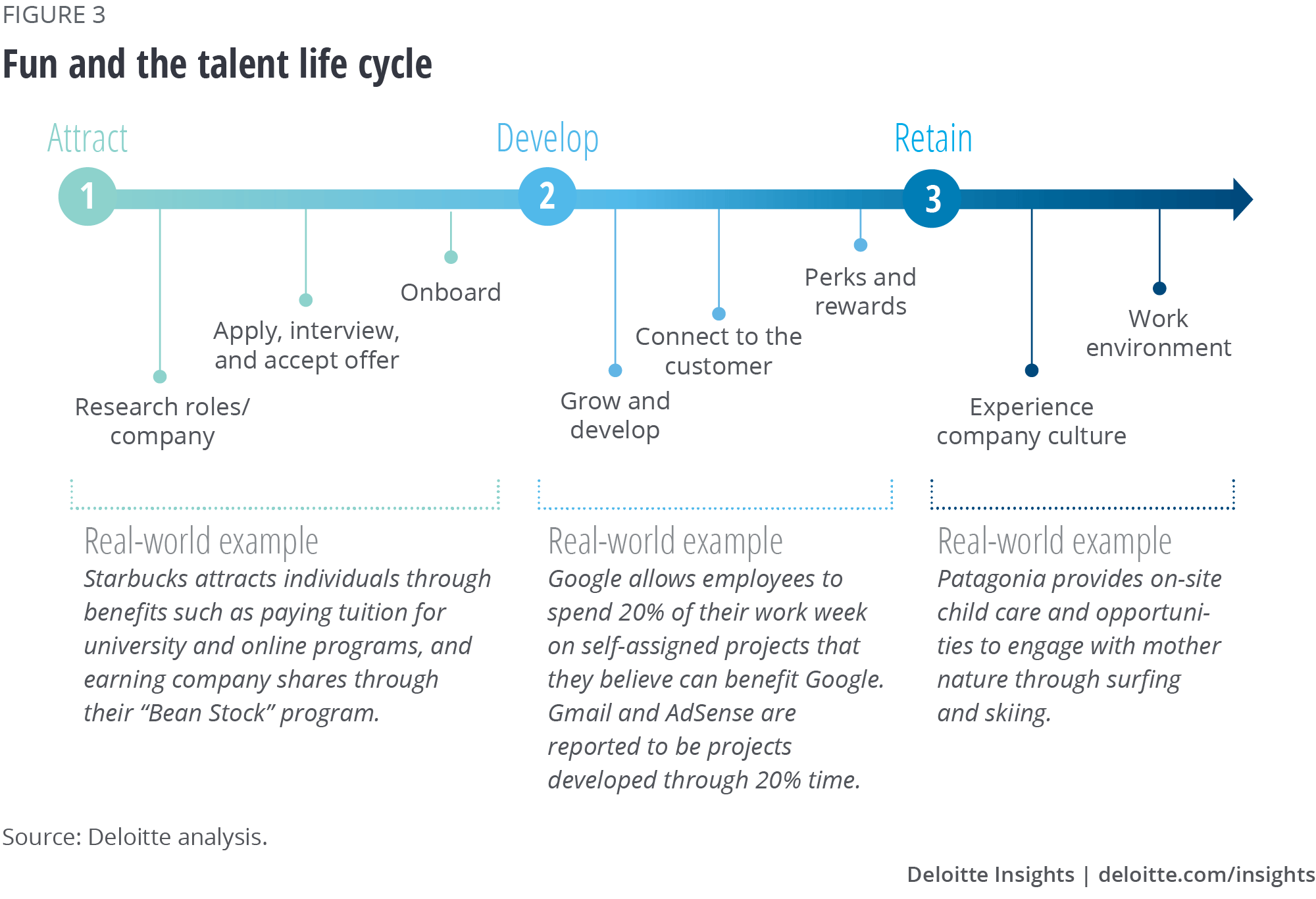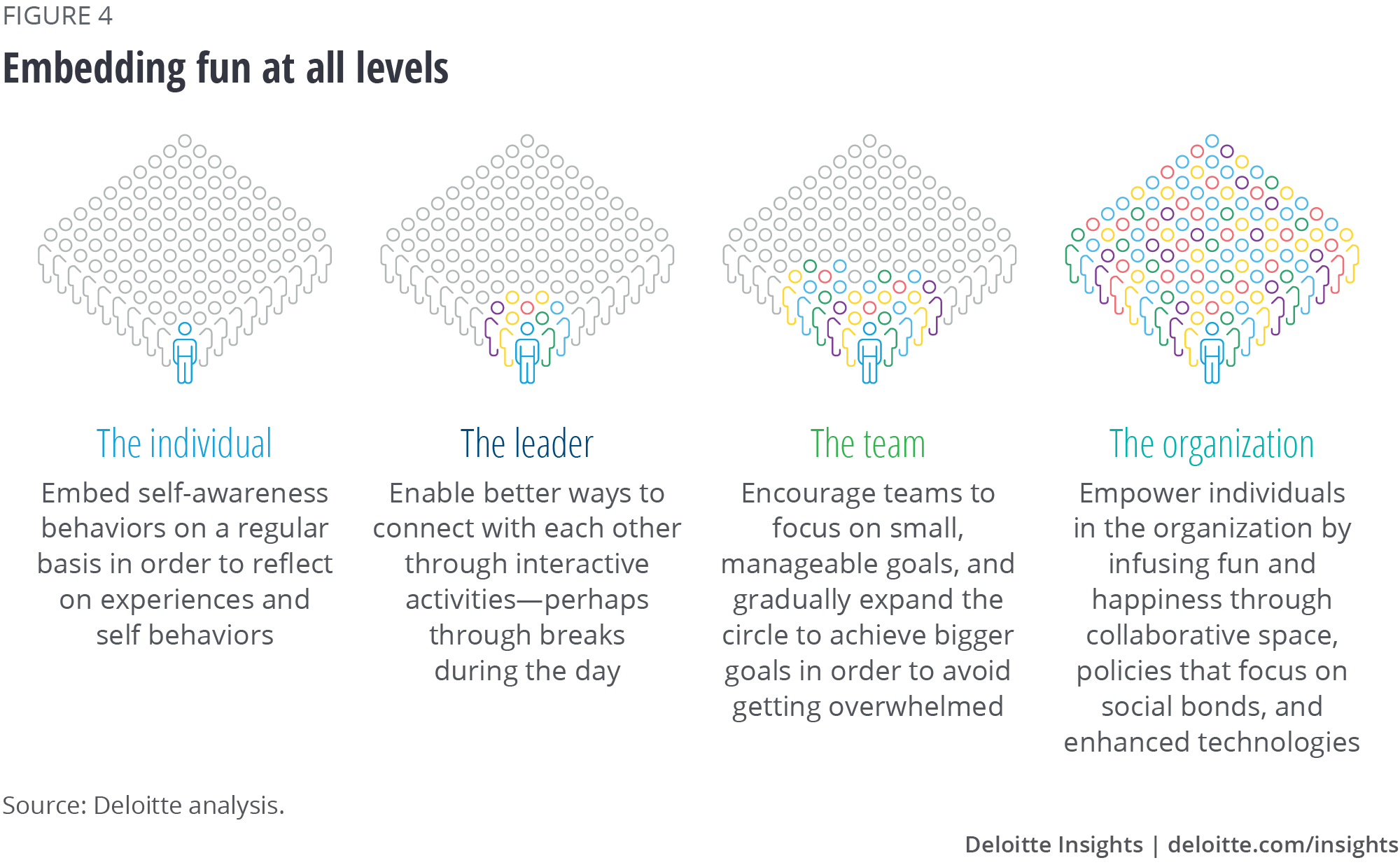
Are you having fun yet? Deloitte Review, issue 24
10 minute read
28 January 2019
Leading companies are discovering there’s a distinct competitive advantage in merging work with play.
Historically work was, well, work. It was about meticulously measured and critiqued efficiency, with breaks or lighthearted moments with colleagues considered taboo. We softened a bit during the 1960s and 1970s, socializing during breaks to smoke or drink, but even these interactions had a stiff formality that hardly promoted letting loose or having fun.1 It is only in the past couple of decades that business leaders have realized what we now know to be true: that humans are inherently social and playful, and introducing these characteristics into the workplace won’t actually hurt the bottom line. Even so, until more recently, a positive, social work environment was merely something “nice to have” rather than essential, because companies figured the real reason employees stayed was for stability, or pay, or prestige.
Enter the latest societal disruption. In a world where technology is exponentially changing personal and business capabilities, job-seekers often have bargaining power and are intentionally looking for employers to fulfill needs beyond material rewards. Many want the ability to work remotely or with schedule flexibility, and the desire for career stability as the end-all, be-all has shifted to a practice of changing jobs frequently to upgrade from a stale environment or to gain new and useful skills. Similarly, the thrill of working for a company with an engaging environment often usurps the traditional appeal of long-standing and reputable organizations. These seismic shifts in how work is viewed lead us to the concept of fun, something that impacts the modern-day environment. Workplace fun is becoming a form of competitive advantage. But what exactly is it?
Learn more
View the Talent collection
Subscribe to receive related content
This article is featured in Deloitte Review, issue 24
Create a custom PDF or download the issue
This is about much more than one-off events or gimmicks—it’s about truly embedding a climate of fun. Building meaningful work in a nurturing environment, filled with growth opportunities underpinned by supportive management and trusted leadership, is increasingly a must-have for organizations that want to thrive. Many companies have already started down this road and some are already the kind of employers that workers flock to, and rivals envy. But there are numerous strategies that can still be deployed by companies to positively change the nature of how people work and, in turn, how much they enjoy what’s inevitably a large part of their lives.
From then to now: What’s changed?
There are three shifts that have created a business opportunity for creating a climate for fun at work.
Shifts in the psychological contract
Understanding how the workplace experience has changed requires understanding the fundamental relationship between employees and employers, which academics call a psychological contract.2 In decades past, many employees were satisfied working for a “winner”—an organization that was performing well financially and in a position to provide them with the stability they desired (see figure 1 for descriptions of how workplaces have—and are—evolving). Today, an increasing number of workers believe business success should be measured by more than just financial performance. So what are they looking for? A fun and engaging experience that drives home the message that their employer cares for its people, not merely the bottom line. We see this shift to a more socially aware and socially connected workplace increasingly being woven into traditional processes related to employee attraction, selection, and retention.

Shifts in workforce demographics
Many of the changes to workplace expectations among employees can be attributed to major shifts in workforce demographics. In 2016, people under the age of 40 became the largest generation at work, comprising 35 percent of the United States labor force.3 Much has been written about the differing needs and expectations millennials have with their employers, but perhaps the most telling piece of information is this: for the first time in many years, young people believe that they will be financially worse off than their parents. This has led to many actively questioning the core premises of corporate behavior and the economic and social principles that guide it. For example, in mature markets, 64 percent of millennials believe they will be less well off financially than their parents and 69 percent say they will be less happy.4 How can businesses fill this growing void? In parallel with providing a corporate mission that inspires and instills pride among employees, they can foster engagement, social opportunities, and fun. We know from research on creating fun climates that social meaning is a fundamental driver of experiencing fun at work.5
Shifts in work itself
With new technologies and the need to solve increasingly complex, messy business problems, it has become important for individuals to reach across organizational boundaries—IT problems no longer remain solely in the IT department. Individuals and especially leaders must foster a deeper understanding of how various departments interact and impact one another, cultivating a systems-minded approach. In fact, 85 percent of C-suite executives rate collaboration as important or very important, yet 73 percent of employees say their leaders rarely, if ever, work together on projects or strategic initiatives.6 This begs the question: how can senior leaders expect their people to collaborate effectively if they are not doing it themselves? Research shows a key driver of collaborative environments is fostering a fun work climate.7
How fun attracts, develops, and retains talent
Though employee expectations, demographics, and work itself have changed during the past 30 years, talent management has often been stubbornly fixed. In the new, open environment of collaboration and growth, the “old rules” of talent management—with employee opportunities bound by considerable organizational constraints—can stifle talent, organizational growth, and productivity. Companies that embrace the new rules shift (detailed in figure 2) can deliver an experience that is differentiated from their competitors and enhances their ability to attract, retain, and develop talent. One common element is a focus on creating and cultivating a climate of fun—one in which establishing and strengthening social connections by providing a variety of differentiating experiences becomes an organizational priority.

But what do we mean by “workplace fun”? Frameworks and definitions abound but, generally, a fun work environment “intentionally encourages, initiates, and supports a variety of enjoyable and pleasurable activities that positively impact the attitude and productivity of individuals and groups.”8 We like this definition for several reasons. First, it’s defining an environment of fun at work, rather than specific activities. The employee experience is a collection of events creating a culture, not one-offs that feel more like checking a box. It also mentions intentionality. Workplace fun can exist organically through, for example, a leader who values having fun at work. We have found that companies that embrace fun as an intentional cultural value tend to have more success because it’s known as a widespread organizational aspiration. Finally, this definition mentions the benefits of workplace fun upfront and recognizes fun can impact both attitudes and behaviors. It’s this combination that can differentiate workplace fun.
One example is US online retailer Zappos, whose 10 core values include fun (“create fun and a little weirdness”) and positivity (“build a positive team and family spirit”).9 Zappos also delivers advice on how to live such values during a three-day culture boot camp, which culminates in a conversation with CEO Tony Hsieh.10
After embedding fun and positivity into the foundation of an organization, there are, of course, events and activities that successful companies use to engage employees. We’ve found workplace fun is used by some organizations to attract, develop, and retain talent (see figure 3) by cultivating cultures people want to join, and are reluctant to leave—a critical competitive advantage.

Attracting talent
In an era of low unemployment, high employee expectations, and myriad job websites, it’s harder than ever to attract the attention of prospective talent. Organizations are recognizing the value of highlighting not only traditional elements such as benefits and key job responsibilities, but the environment potential candidates will join—some even encourage applicants to speak with existing employees to get a feel for their culture. At the same time, companies use websites and social media to portray themselves as a fun place to work, describing their history, vision, values, and seeking to provide an inside view of the people that work there. This effort to inject fun into recruiting doesn’t stop once an employee has been hired. Onboarding presents a unique opportunity to express company values and put employees on a path to success.
For example, Bonobos asks hiring managers to email the entire organization to announce new hires, including picture and a biography of the newcomer, along with a trivia game “two truths and a lie.” Employees are encouraged to select which of the three statements about the new employee is false, with a US$25 store credit awarded to the fastest correct response. Online retailer Warby Parker has “lunch roulette,” where employees from different departments are randomly selected to enjoy lunch on the company’s dime in an effort to promote cross-functional connections.11 When attracting employees, there’s no limit to the number of creative methods companies may use, during both pre- and post-hire phases.
Developing talent
Once employees experience an enjoyable onboarding process and determine an organization is a good fit, they’ll likely start looking for growth opportunities. Companies that have addressed this stage offer a variety of options to learn and grow both professionally and personally, and we find crafting development opportunities through the lens of the customer experience is critical to connecting an individual or team’s work to the company’s broader goals.
For example, Best Buy sought feedback from employees on how to provide a unique customer experience in its retail stores, resulting in the opening of an “experience store,” where customers could test the latest technologies in a highly immersive environment.12 When Southwest Airlines introduced the all-new Boeing 737 Max into their fleet, it included a third galley area allowing flight attendants to serve customers with greater ease, an enhancement that was brought about via employee input sought during the design phase.13 Lego offers an annual “play day,” where employees have the day off to simply play with Lego products.14 All are examples of organizations empowering employees and expanding their sphere of influence by making an intentional effort to connect them to the customer experience in engaging, playful, and fun ways.
Retaining talent
Companies leading the way in creating fun climates are not merely throwing ideas at the wall to see what sticks. They’re using big data and analytics to think strategically about what kinds of activities support a climate of fun, and fine-tuning accordingly. Rather than simply asking individual employees “are you having fun?,” companies are using pulse surveys and soliciting qualitative feedback to gather large amounts of data that can be analyzed to gain a deeper understanding of what employees, as a group, look for. This move toward the collective—asking “are we having fun?”15—intentionally shifts the focus toward creating a culture of fun that aligns with external, publicized values.16
When New Belgium Brewing Company named its second employee “director of fun,” it likely didn’t have a clear concept of what would follow.17 But that senior leader, Brian Callahan, has since helped to inject fun into the physical work environment, with the Colorado-based company’s headquarters now boasting a rock climbing wall, ping-pong table, and slide among its designated fun and social spaces.18 This not only helps retain existing talent but feeds the attraction of new employees.
Embedding fun into the workplace
It’s easy enough to declare that fun should be an organizational priority, embedded from top-down and bottom-up, across 360-degrees. What’s harder is execution, and it requires using different tiers of the organization to enable fun, with each dimension feeling a sense of ownership of and accountability for creating and sustaining the corporate climate. By fostering a sense of responsibility at an individual level, organizations can help fun impact teams, leaders, and the overall organization (see figure 4). And, of course, all of these levels are interdependent, and only as strong as the weakest link.

The individual
While goals, resources, and other mechanisms for the “what” of delivering work may be out of employees’ direct control, every individual has the power to voice ideas for constructing the “how” of achieving organizational expectations. This idea, often referred to as job crafting, provides individuals with the opportunity to improve their personal experience at work by creating workplace fun through their own lenses. Employees can consider several ways to meaningfully drive this change and impact how much fun they have, among them: directing their communication with other members of the organization, determining how to execute their own tasks, and engaging with a lens of valuing the work they perform.19 All of these example tactics are a strong starting point for building fun into broader team and organizational tiers.
The team
Teams are a great way to show the fabric of individuals as contributors to a greater group, especially when teams allow individuals to feel comfortable expressing playfulness and humor. This sense of trust in the workplace—to be your authentic self—is enabled through the social interactions generated by teams. Collaboration is the glue that holds teams together, and the odds of a well-functioning team rise exponentially as employees feel comfortable being their true selves at work, displaying integrity, forgiveness, trust, and humanity. This can ultimately lead to a greater likelihood for a climate of fun. Positivity, enabled by self-motivation, is also incredibly important to fostering the strong social aspects of fun at work.
The leader
Leaders connect teams to the broader organization, and share responsibilities that influence how they can support fun in the workplace. For instance, leaders can provide opportunities for individuals to experience fulfillment or joy from specific tasks, therefore improving peoples’ perception of fun in the organization. They can (and should!) lead by example—by being ambassadors, leaders can drive the balance between fun and work and build environments that encourage and accept fun and playfulness at work. Fostering trust and maintaining open lines of communication can promote workplace fun and happiness, and are essential for team cohesion and collaboration (as well as overall work satisfaction). Leaders play a critical role in creating a trusting environment in which everyone is more likely to be more authentic, vulnerable, and have a positive frame of mind.
The organization
Whenever possible, organizations can embed fun into processes. Employees can be recognized for specific milestones such as birthdays or tenure, and there can be social activities and other celebrations. Organizations can also encourage a climate of fun through the adoption of games, contests, and other events that are not directly related to daily work. While we accept that notions of fun and happiness are highly subjective, and culture is not something that can be changed overnight, the creation of an environment that encourages fun through employee behavior can improve the overall perception of work and in turn, can potentially increase productivity and decrease turnover.
What about specific perks or rewards for people who demonstrate an aptitude for fun? Since there are direct positive correlations between self-reflection, performance, and creativity, organizations can consider creating innovative engines for fun idea creation and solicit these ideas from the broader employee population.20 Where people are co-located, it’s important to create space for people to interact openly and with others that may be working virtually, such as through differentiated physical layouts of the work environment (such as closed cubicle spaces versus open, large tables with multiple chairs). Fundamentally, organizations should provide opportunities for individuals to embrace ways of having fun and create mechanisms for tracking impact and output so everyone knows what the organization values.
Now what?
You know what you’re up against—the working world has shifted. For organizations to thrive rather than merely survive in this era of evolving employee expectations and increasing competition, they should embrace fun to create a positive climate that improves the employee experience. Leading organizations are anticipating and proactively changing, paving the way for embedding various aspects of fun at work. Consider fun as a way to shake up your organizational culture—you may be surprised at its spark.
© 2021. See Terms of Use for more information.
Explore the issue
-
The digital banking global consumer survey Article6 years ago
-
Can we realize untapped opportunity by redefining work? Article6 years ago
-
The Industry 4.0 paradox Article6 years ago
-
Tax governance in the world of Industry 4.0 Article6 years ago
-
Regulating the future of mobility Article6 years ago
-
Seleta Reynolds aims to bring 21st-century mobility to a city built for cars Article6 years ago



















